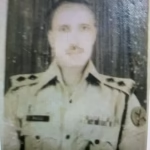**The Untold Story of Survival and Liberation: A 1971 Journey of Hope and Resilience**
The preface of any book serves as the gateway to the author’s world. It sets the tone and provides a glimpse into the mind and soul of the writer. For a book chronicling personal experiences of war, survival, and the quest for national freedom, the preface holds even more significance. It not only establishes the emotional depth of the narrative but also prepares the reader to embark on a journey through the turmoil and triumphs of a historic period. Such is the preface to A Refugee Journey: Surviving Bangladesh Genocide and Liberation War, 1971, a narrative that will deeply connect you with the author’s experiences.
The journey of writing this book, as expressed in the preface, has been one of revisiting painful memories and resurrecting buried emotions. It has been a deeply personal expedition through time, reawakening the sights, sounds, and scars of a nation struggling to find its voice amid the thunder of war. The book emerges from these intense recollections as a testament to the resilience of the human spirit, a story that will inspire hope and determination in the face of insurmountable odds.
### A Nation’s Birth Through the Fires of Conflict
In 1971, Bangladesh stood at the crossroads of history, facing a brutal genocide that claimed countless lives and left deep, indelible scars on those who survived. It was a time of darkness when the very fabric of society was torn apart. Families were displaced, villages were decimated, and entire communities were forced into exile. Amidst this chaos and carnage, a dream persisted—a dream of an independent Bangladesh, free from oppression, where its people could live with dignity and peace.
This book is more than a mere chronicle of events; it is a living, breathing narrative that captures the essence of what it means to be caught in the tide of history. It is a story of survival, of finding hope in the darkest of times, and of a people’s unyielding determination to rise from the ashes of war and build a new nation. Each chapter unfolds like a vivid painting, depicting the horrors of war, the sacrifices of countless souls, and the extraordinary courage shown by ordinary men and women.

### Personal Journey Intertwined with National Struggle
The author’s experiences during the liberation war are intertwined with the broader narrative of Bangladesh’s struggle for independence. As a refugee swept along in the tide of conflict, the author’s journey is emblematic of the countless others who endured unspeakable hardships yet held on to the dream of freedom. The book captures the harrowing reality of fleeing one’s home, seeking safety amidst the uncertainty of war, and navigating the treacherous terrain of survival.
The preface speaks to the emotional toll of reliving these experiences in the process of writing. Every word penned is laden with the weight of the fallen, the cries of the displaced, and the silent resolve of those who dared to dream of a free and independent Bangladesh. It is a tale of heartbreak and hope, a tribute to those who lost their lives, and a celebration of the human spirit’s capacity to endure.
### The Role of Family and Friends in Shaping the Narrative
No story of war and survival is complete without acknowledging the roles of those who provided strength and support during the darkest times. The author’s journey in writing this book was supported and shaped by the unwavering encouragement and inspiration from loved ones. Fatema, the author’s dearest friend and devoted wife, emerges as a central figure in this narrative. Her strength, patience, and belief in the importance of telling this story provided the author with the space and courage needed to delve into such painful memories.
Similarly, the author’s children, Sabreena and Safwaan, played a crucial role in refining the book’s contents. Their insights and guidance helped bridge the gap between the events of 1971 and the narrative style of the 21st century. They brought fresh perspectives and helped shape the book’s tone to resonate with contemporary readers. Their involvement is a testament to the power of intergenerational storytelling, where history is not just recounted but also reinterpreted to ensure its relevance for future generations.
### Bringing History to Life Through Art
One of the unique aspects of this book is the inclusion of paintings that depict the author’s journey through the liberation war. These paintings are not mere illustrations; they are vivid, powerful representations of the tumultuous journey undertaken in 1971. The preface acknowledges the contributions of Dr. Mohammad Emad Uddin, whose vision and determination to have the various phases of the author’s journey depicted on canvas added a new dimension to the storytelling.
The paintings were brought to life by the acclaimed artist Abu Jafar, who listened intently to the author’s descriptions and narrations, and translated them into evocative visual masterpieces. Each canvas tells a story of its own, capturing the essence of the author’s experiences and presenting them in a way that words alone cannot. These paintings serve as a bridge between the past and the present, allowing readers to visualize the struggles and sacrifices of those who lived through the war.
The visual depictions are not just art; they are narratives in their own right, capturing the endurance, resilience, and bravery of a people determined to chart their own destiny. They add depth and context to the book, enriching the reader’s understanding of the events and emotions that shaped the author’s life and the nation’s history.
### Reflections on the Genocide and Liberation War
The genocide of 1971 is a chapter in history that should never be forgotten. The atrocities committed during the war left an indelible mark on the collective consciousness of Bangladesh and the world. The preface emphasizes the importance of remembering these events, instilling in the readers a sense of responsibility and respect for the past.
The book stands as a record of the genocide, capturing the brutality of the perpetrators and the suffering of the victims. It also serves as a reminder of the power of solidarity and the strength of a people united in their quest for freedom. It is a story of defiance in the face of tyranny, of holding on to hope when all seemed lost, and of rising above the pain and loss to forge a new path forward.
### The Legacy of 1971 and Its Relevance Today
While the events of 1971 are now part of history, their legacy continues to shape the identity and values of Bangladesh. The struggle for independence was not just a fight for territory; it was a fight for the right to self-determination, for the dignity of every individual, and for the principles of freedom and justice. These values remain as relevant today as they were over fifty years ago.
The book, through its personal narrative and historical context, serves as a reminder of the price paid for these values. It calls on readers to honor the sacrifices of those who fought for independence and to uphold the principles for which they gave their lives. It is a story that resonates not just with the people of Bangladesh but with anyone who believes in the power of the human spirit to overcome adversity and build a better future.
### The Power of Storytelling in Preserving History
Storytelling has always been a powerful tool for preserving history and passing on lessons from one generation to the next. The preface highlights the importance of storytelling in ensuring that the events of 1971 are not forgotten. Through this book, the author has created a narrative that captures the essence of a people’s struggle and survival, providing a window into the past that will inspire and educate future generations.
The inclusion of personal anecdotes, reflections, and visual representations makes the story accessible and relatable, allowing readers to connect with the events on a deeper level. The book is not just a recounting of history; it is an invitation to engage with the past, to reflect on its lessons, and to draw strength and inspiration from the resilience and courage of those who lived through it.
### A Tribute to Those Who Made the Book Possible
The preface concludes with heartfelt gratitude to those who played a role in bringing the book to life. The author’s acknowledgments go beyond mere formalities; they are expressions of deep appreciation for the support, encouragement, and inspiration provided by family and friends. It is a reminder that behind every book, especially one dealing with such personal and emotional subjects, is a network of individuals who contribute in countless ways.
Fatema’s unwavering support, the contributions of Sabreena and Safwaan, the artistic vision of Dr. Mohammad Emad Uddin, and the artistic talents of Abu Jafar—all played a crucial role in shaping this book. Their contributions enriched the narrative, adding depth and dimension to the story and ensuring that it resonated with readers on multiple levels.
### Final Thoughts: The Importance of Remembering
*The Refugee Journey: Surviving Bangladesh Genocide and Liberation War, 1971* is not just a book; it is a testament to the power of memory, the strength of the human spirit, and the importance of bearing witness to history. It is a story that needs to be told and retold, not just for the sake of those who lived through it but for the generations that follow.
The preface serves as a fitting introduction to this powerful narrative, setting the stage for a journey through the horrors of war, the pain of displacement, and the triumph of the human will. It invites readers to reflect on the past, to honor the sacrifices made, and to draw inspiration from the resilience and courage of those who dared to dream of a free and independent Bangladesh.
Through this book, the author has ensured that the events of 1971 will not be forgotten—that they will continue to inspire, educate, and remind us of the enduring power of hope, courage, and the human spirit.














